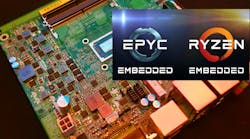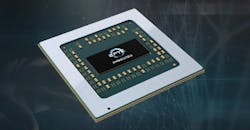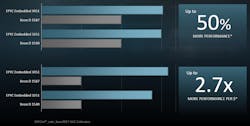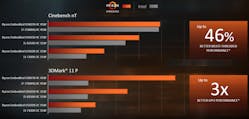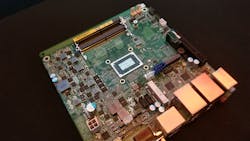Developers looking for embedded processors tend to have more demanding requirements than those used in PCs and servers. This can include a wider operating temperature range or a longer life cycle. The latter typically extends beyond five years, with many being used for 10 or 20 years.
Along these lines, AMD announced its EPYC Embedded and Ryzen Embedded processor families to target the embedded space. These are compatible with the EPYC server chips and Ryzen processors. AMD is providing long-term support and availability for these families.
It’s EPYC
The EPYC Embedded 3000 (Fig. 1) is built on the same platform as the EPYC 7000 server chips. The embedded version sports a maximum of 16 Zen cores with up to a 32-MB shared L3 cache. The EPYC Embedded 3000 has four independent memory channels and up to 64 PCI Express Gen 3 lanes. It has a primary frequency of 2.15 GHz and a boost frequency of 3.1 GHz. Systems can handle up to 1 TB of memory.
1. The EPYC Embedded brings the EPYC server family to the embedded space.
The EPYC Embedded 3000 system-on-chip (SoC) doesn’t require additional support chips. It incorporates up to eight 10-Gb Ethernet ports and up to 16 SATA/NVMe ports.
The embedded family currently matches the midrange EPYC 7000 server chips that have up to 32 cores and 128 PCI Express lanes. The EPYC family also shares a security system with a secure Cortex-A5 processor that provides a secure root-of-trust. They also support Secure Memory Encryption (SME) and Secure Encrypted Virtualization (SEC).
SME works with encryption and decryption hardware that’s integrated with the memory controllers. Data in DRAM is always encrypted with SME enabled. It’s decrypted as it comes into the SoC and is encrypted before being written to memory. SME is a BIOS option that allows it to be used transparently with respect to the operating system and applications. The secure processor manages the encryption keys.
SEC is a bit more complicated. It also uses SME, but is employed on a virtual-machine (VM) mode. Each VM has its own encryption keys that are managed by the secure processor. This allows the system to be used with an unsecured hypervisor since the encryption is managed by the chip. The hypervisor manages memory and the VM and doesn’t care that it’s encrypted. Of course, some hypervisor modifications are needed to support SEC properly. These have been incorporated into the mainline Linux implementation as well as other operating systems.
There’s an overhead for SEC but it is very small. It also applies only to an encrypted VM. The hypervisor can handle both types of VM. As with SME, security is transparent to the application or VM.
2. Price-to-performance ratio of the EPYC Embedded outshines the competition.
EPYC Embedded competition includes Intel’s Xeon D. EPYC Embedded’s performance is better, but its price/performance is the more impressive difference (Fig. 2). This is due to AMD’s lower price. That’s something Intel could match with a price drop, but for now AMD has the price/performance edge. The EPYC Embedded 3451 is priced at $880, while the Xeon D-2191 goes for $2407.
A range of the latest operating systems support EPYC Embedded, including Red Hat Linux, Canonical’s Ubuntu, Mentor Graphics’ Mentor Embedded Linux (MEL), Wind River’s Wind River Linux Base, and the latest Yocto project.
Ryzen to the Occasion
3. Unlike the EPYC Embedded, the Ryzen Embedded incorporates a GPU.
EPYC Embedded doesn’t include a GPU, but one is integrated into the Ryzen Embedded (Fig. 3). The Ryzen Embedded V1000 APU also has Zen cores, and includes an AMD VESA GPU using a Heterogeneous System Architecture (HSA). The video support can handle up to four 4K displays. It’s 4K60 encode/decode support includes H.265 and VP9. The single-chip solution handles HDMI 2.0b, DisplayPort (DP) 1.4, and eDP1.4. The chips have dual 10-Gb Ethernet, allowing them to be used for gateways. The CPU, GPU, and peripherals are tied together using AMD’s Infinity Fabric.
Versions are available with power requirements from 12 to 54 W. There are two- and four-core versions that run two threads per core. The base frequency is 1.3 GHz, with a boost speed up to 3.8 GHz. The top-end V1807B has 11 GPU compute units.
4. The Ryzen Embedded’s main competition is Intel’s Core family.
The Ryzen Embedded family competes with Intel’s Core family (Fig. 4). AMD’s processors shine when it comes to GPU performance. The family is supported by Microsoft Windows 10, Canonical Ubuntu, Mentor Graphics’ MEL, Wind River’s Wind River Linux Base, and the latest Yocto project.
Systems that utilize the EPYC Embedded and Ryzen Embedded chips are already finalized. In fact, a number of motherboards and modules using the Ryzen Embedded processors are being shown at this year’s Embedded World. For example, the iBase MI988-A is a Mini-ITX motherboard with a Ryzen Embedded V1000 processor (Fig. 5). The board exposes HDMI, DisplayPort, eDP, and 24-bit dual channel LVDS displays. The board has dual Ethernet ports, a PCI Express socket, and an M.2 socket.
5. The iBase MI988-A is a Mini-ITX motherboard that integrates a Ryzen Embedded V1000 processor.
One feature that makes the Ryzen Embedded chips stand out is security. They also can handle the SME, SEV support and secure boot found in the EPYC processors.
Ryzen Embedded processors are ideal for many applications, such as medical systems and gaming systems, due to its graphics capabilities. These applications require the advanced security features found in AMD’s latest chips.
